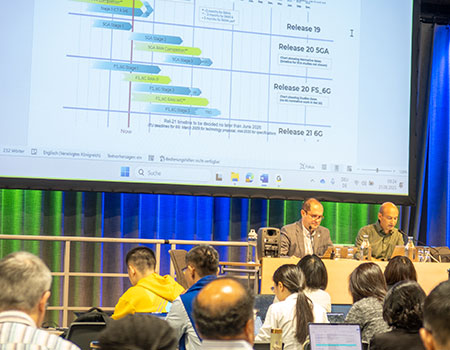By Simon Fletcher, CSO, SCF
First published June 2024, in Highlights Issue 08
In a market and ecosystem of increasing complexity, partnership and cooperation are vital ingredients for success, and principles that sit at the core of SCF. Our mission is to support interoperability and ensure architectural and supplier choice across a range of scalable infrastructure for an evolving ecosystem of service providers and network deployers. SCF has been a Market Representation Partner (MRP) of 3GPP ever since working closely with 3GPP on the defining of 3G and 4G in-building consumer basestations.
Although our interests have broadened – as we outline below – we do see a necessary coming together between the 3GPP memberships and our own diverse industry membership as the Open RAN market starts to help shape the next generation of 3GPP and non-3GPP systems. We pride ourselves on offering an environment focused on collaboration. I hope that this article will be of interest to the 3GPP community.
Recently, we have strengthened our collaborations with OpenAirInterface (OAI) and the O-RAN Alliance by the signing of a comprehensive Cooperation Agreement with the O-RAN Alliance. This has been a long standing partnership, with our shared membership and common commitment to the Open RAN ecosystem. The SCF work program now includes close cooperation with the O-RAN Alliance to support specification development and activities to accelerate commercialization of small-cell open RAN solutions.
In-flight work and emerging market dynamics
SCF has a robust technical work program which includes close cooperation with the O-RAN Alliance to support specification development and activities to accelerate commercialization of small-cell open RAN solutions.
FAPI (Functional application platform interface) is a common standard agreed between chipset and component suppliers and mobile base station integrators. It is an API for hardware components implementing 3GPP physical layer functions and “software stacks” implementing higher layers. Since SCF created the standard, FAPI has been widely adopted in the vast majority of 2G, 3G and 4G system-on-a-chip based small cells.
SCF has now published five specifications within 5G FAPI, its landmark family of common interfaces. The suite is regularly updated to ensure it meets industry needs and aligns with 3GPP standards. Significant work is already underway with SCF and the O-RAN Alliance to mature the FAPI and nFAPI (for virtualization) split-6 options.
The new Cooperation Agreement with the O-RAN Alliance identifies key areas of collaboration, including: requirements, workplans, development of 5G/6G-(n)FAPI interface specification, disaggregated architectures, RAN Intelligent Controller (RIC) interactions, management solutions, test and verification, and reference implementations.
Near-term technical goals under the agreement include the continued alignment of specifications and the development of management solutions for Split-6 (FAPI/nFAPI) RAN.
But the collaboration on the 5G/6G-(n)FAPI interface specification extends beyond merely signing documents. At the end of 2023, SCF, OAI and the O-RAN Alliance convened in Boston for a hands-on workshop which explored common interests in each organization’s activity roadmaps and in particular how split 7.x and split6 in the disaggregated RAN could evolve. SCF develops FAPI by reference to both 3GPP and O-RAN Alliance technical specifications depending on the features that are being developed in FAPI at the time.
Realising Open RAN, more quickly
The hoped for benefits of Open RAN are well established yet much of the industry remains frustrated by the slow rate of deployment. At the recent Small Cells World Summit (SCWS), market analysts explored the reasons behind this, specifically the absence in mature market macro networks for green field opportunities and the long-term nature of commercial contracts between suppliers and Operators which will inevitably create the impression of inertia for a while.
By contrast, special and multi-purpose networks using smaller form factor base stations (including compact macro) are typically driven by green field densification and cost sensitive coverage solutions. As a result, the notable exception in the Open RAN deployment story to date is small cells, where progress has been earlier and faster than elsewhere. Indeed, BT and Wireless Infrastructure Group at SCWS were able to point to concrete steps forward and a roadmap to harness Open RAN and improve the economics of densification.
Against this backdrop of market reality, the closer alliance between our organizations makes perfect sense. Beyond the specifics of technical endeavours – of which there are plenty – our deepening partnership enables us to more effectively share knowledge and collaborate for the benefit of the entire Open RAN ecosystem.
Increasingly, we’re seeing that the group of alternative network operators some of which enable shared network infrastructure (referred to as Neutral Hosts) are emerging as influential buyers of equipment from the product sectors that SCF represents. Initiatives like Joint Operators Telecom Specification (JOTS), which started in the UK and is being explored in other markets, show that it is possible for MNOs to define the acceptable deployable specifications of systems, providing the groundwork which third parties can then build on to create the deployment market.
At a market level however we’re observing that RAN sharing architectures may need to evolve as the long established Multi Operator Core Network (MOCN) and Multi Operator RAN (MORAN) approaches have been standardized for some time, but when combined with new thinking on disaggregation towards 5G-Adv - and beyond - and NTN product platform changes may be needed. The JOTS forum has recently developed additional specifications for addressing security and related aspects, and similar initiatives are being pursued by ATIS. Security is of solutions is of great import to the SCF.
Led by our MNO and neutral host members, SCF is therefore working to explore whether a baseline blueprint for a global sharing framework is possible or even desirable. Such a framework would leverage global best practice and highlights perfectly the critical value of collaborations between SCF and organizations such as OAI and the O-RAN Alliance, plus other bodies.
Closer working relations not only enables wider understanding, but can also ensure consistency, and avoid fragmentation or duplication of efforts. In an increasingly complex and multi-layered ecosystem with new types of service providers, the value of this cannot be overstated. It is through partnerships, alliances and collaborations that we jointly have the opportunity to enact real-world, measurable progress to realising the ever-increasing demands for advanced connectivity.
Security and Management (SMO) provides another opportunity for – and example of - alignment and partnership between SCF and other organizations. We see SMO becoming increasingly essential to smooth the integration of multi-purpose networks into public, hybrid and private network deployments, and are consequently exploring and then exploiting the synergies between the works of OAI, O-RAN Alliance & OnGo Alliance.
The pathways to 6G
With work underway to start defining the standards for 6G, the industry inevitably turns its attention to what’s coming next. But we cannot wait for 6G – with a putative date of 2030+ - to realise broad-scale Open RAN market adoption.
Instead, as both a Market Representation Partner of 3GPP and an industry partner with the O-RAN Alliance, SCF is focusing on driving the adoption of 5G towards 5G-Advanced, maximising the return on investment for R&D developments that we’ve seen being made for a number of years. The approach to inclusion of space-based systems and densification that is inclusive of new spectrum bands creates opportunities during 5G deployment to create value. Nevertheless, as the economically viable pathways of industry members towards 6G become apparent, SCF anticipates a rethink on disaggregation in the RAN and perhaps in other areas of the networks. With that in mind - we have been observers of the recent SA1 6G Use Cases workshop and plan to focus on the path to architectures through engagement with 3GPP and O-RAN Alliance future architecture deliberations when appropriate. Contributions from SCF through PCG of 3GPP are anticipated over the coming year.
Looking ahead, we have identified longer-term technical goals to tackle with OAI and the O-RAN Alliance, including the development of reference implementations and integrated test and verification processes.
Softwarization is a trend expected to be significant in the future of networks and OAI sets a template for the open source model in RAN. There are of course commercial models linked to Open Source but these need to mature and SCF emerges as a trade organization able to help the ecosystem commoditize solutions.
We also recognize that the pathways to 6G will be paved with innovations in silicon at the techno-economic edge of national operator networks. Achieving cost and power optimal solutions, that work for the economics of special and multi-purpose networks, addressing the varied needs from coverage in remote and rural locations to densification for capacity and full service availability area networks needs a variety of chip options for product developers.
Our sector is a complex and multi-faceted one: the risks of duplication, fragmentation and confusion are great. Strategic partnerships and collaborations offer a clear route forward to more effectively meet latent demand, overcome challenges and realise the potential of Open RAN, emerging technologies and future networks.
We have a deeply embedded pragmatism that runs throughout SCF as we strive to get real about the future and identify how we can shape and promote new product development and practical solutions to monetizing telco investments. As in the past work on Femto-cells, we hope that we can be a catalyst for future work in 3GPP, that harnesses the power of the 3GPP RAN and growing potential for an Open RAN.



 Partners News
Partners News 




